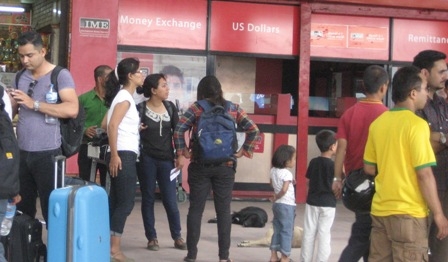International tourist arrivals up in eight months of 2014

Madrid : International tourist arrivals worldwide grew by 5% during the first eight months of 2014 according to the latest UNWTO World Tourism Barometer. Despite geopolitical challenges and a lingering economic recovery, tourism demand was strong during the northern hemisphere high season of June to August.
International tourists (overnight visitors) travelling the world between January and August 2014 reached 781 million, 36 million more than in the same period of 2013. With a 5% increase, international tourism continued to grow well above the long-term trend projected by UNWTO for the period 2010-2020 (+3.8%). The peak months of June, July and August, which account for about one third of the total of the year, saw an increase of 4% compared to the same months of 2013.
By region, the strongest growth was registered in the Americas (+8%), followed by Asia and the Pacific (+5%) and Europe (+4%). By subregion, North America (+9%) and South Asia (+8%) were the star performers, as well as Southern and Mediterranean Europe, Northern Europe, North-East Asia and South America (all +7%).
“International tourism continues to grow above expectations despite rising global challenges”, said UNWTO Secretary-General, Taleb Rifai. “Yet, increasing geopolitical uncertainties and the fact that the global economy shows signs of weaker and uneven growth require our attention”, he added.
Commenting on the possible impact of the Ebola outbreak in West Africa on tourism, Mr. Rifai said “Although it is too premature to assess the full impact of the outbreak on the tourism sector, at this point we do not expect a major effect on the sector globally.”
“International tourism in countries where there is widespread transmission (Liberia, Guinea and Sierra Leone) represents less than 1% of all international arrivals to African destinations. Yet we have to be aware that misperception about the outbreak is affecting the whole of Africa. On the upside, and according to information gathered from our African Member States and key tour operators and associations in major source markets, there are no significant cancellations to report, despite a certain slowdown in bookings”.
Mr. Rifai recalled that the 3rd meeting of the International Health Regulations Emergency Committee regarding the 2014 Ebola outbreak in West Africa convened by the World Health Organization (WHO) on 23 October 2014 “reiterated its recommendation that there should be no general ban on international travel or trade.”
“Most importantly, we need to urgently step up international efforts to support affected countries to contain the outbreak, ensure that WHO recommendations are implemented and provide, at all moments, transparent and timely information to fight misperception and fear, and minimize the spillover effects to the whole region”, he added.
The Americas: leading growth in 2014
The Americas (+8%) led growth during the first eight months of 2014, rebounding on last year’s subdued results. All four subregions – North America, Caribbean, Central America and South America – doubled the growth rates registered in 2013.
International arrivals in Asia and the Pacific increased by 5%, consolidating the growth of recent years, with South Asia (+8%) and North-East Asia (+7%) in the lead, followed by Oceania (+6%). On the other hand, growth in arrivals slowed down in South-East Asia (+2%) compared to the strong results registered in 2012 and 2013.
Europe, the most visited region in the world, posted 4% growth in international tourist arrivals through August, with strong results in Northern Europe and Southern Mediterranean Europe (+7% each). By contrast, international tourism grew at a more modest pace in Western Europe (+3%) and was stagnant in Central and Eastern Europe (-1%).
Africa’s international tourist numbers grew by 3% with North Africa consolidating its recovery (+4%). Sub-Saharan Africa’s arrivals were up by 3%.
International tourist arrivals in the Middle East are estimated to be up by 3%, though this figure should be read with caution as it is based on limited available data for the region.
China reinforces its position as leading source market
Data on expenditure on travel abroad for the first six to nine months of 2014 indicates that growth among the world’s top ten source markets was highest in China (+16%), while France (+10%), Italy (+8%), the United States of America (+6%), Brazil (+5%) and the Russian Federation (+4%) also reported robust growth. Among the top 25 source markets in expenditure, double-digit growth rates were registered in India (+31%), Norway (+22%), Sweden (+12%), Taiwan (pr. of China) (+11%) and the Republic of Korea (+10%).
2014 to close above expectations
For the full year 2014, international tourist arrivals are expected to increase by 4% to 4.5%, slightly above UNWTO’s long-term forecast of 3.8% per year for the period 2010 to 2020.
Although the UNWTO Confidence Index shows some weaker levels due to the current geopolitical and health risks, results remain positive as 51% of respondents see prospects for the period September-December 2014 as “much better or better” as against 35% who rate it as “equal” and 14% as “much worse or worse”. – UNWTO
Oct. 31, 2014
















